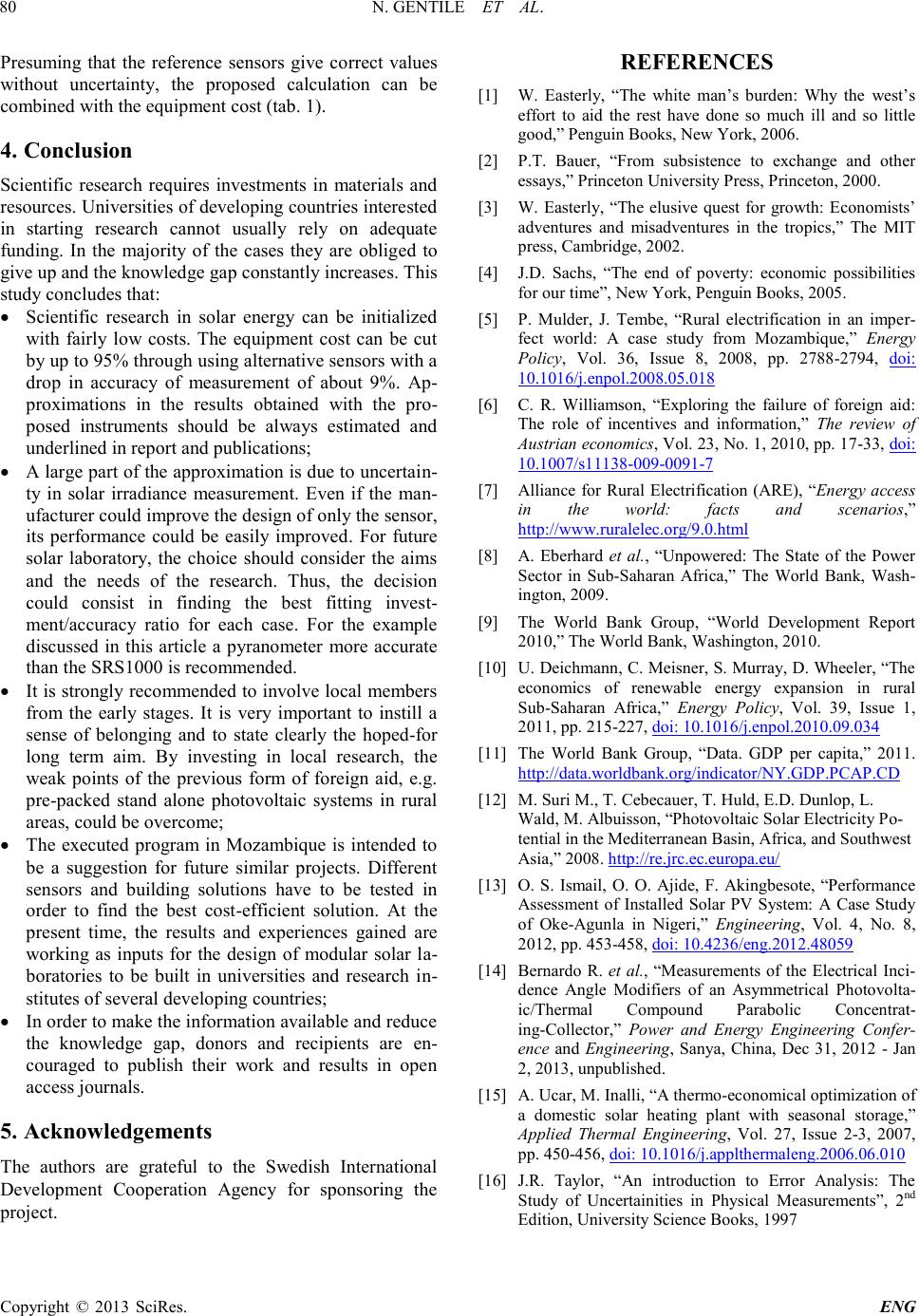
N. GENTILE ET AL.
Copyright © 2013 SciRes. ENG
Presuming that the reference sensors give correct values
without uncertainty, the proposed calculation can be
combined with the equipment cost (tab. 1).
4. Conclusion
Scientific research requires investments in materials and
resources. Universities of developing countries interested
in starting research cannot usually rely on adequate
funding. In the majority of the cases they are obliged to
give up and the knowledge gap constantly increases. This
study concludes that:
Scientific research in solar energy can be initialized
with fairly low costs. The equipment cost can be cut
by up to 95% through using alternative sensors with a
drop in accuracy of measurement of about 9%. Ap-
proximations in the results obtained with the pro-
posed instruments should be always estimated and
underlined in report and publications;
A large part of the approximation is due to uncertain-
ty in solar irradiance measurement. Even if the man-
ufacturer could improve the design of only the sensor,
its performance could be easily improved. For future
solar laboratory, the choice should consider the aims
and the needs of the research. Thus, the decision
could consist in finding the best fitting invest-
ment/accuracy ratio for each case. For the example
discussed in this article a pyranometer more accurate
than the SRS1000 is recommended.
It is strongly recommended to involve local members
from the early stages. It is very important to instill a
sense of belonging and to state clearly the hoped-for
long term aim. By investing in local research, the
weak points of the previous form of foreign aid, e.g.
pre-packed stand alone photovoltaic systems in rural
areas, could be overcome;
The executed program in Mozambique is intended to
be a suggestion for future similar projects. Different
sensors and building solutions have to be tested in
order to find the best cost-efficient solution. At the
present time, the results and experiences gained are
working as inputs for the design of modular solar la-
boratories to be built in universities and research in-
stitutes of several developing countries;
In order to make the information available and reduce
the knowledge gap, donors and recipients are en-
couraged to publish their work and results in open
access journals.
5. Acknowledgements
The authors are grateful to the Swedish International
Development Cooperation Agency for sponsoring the
project.
REFERENCES
[1] W. Easterly, “The white man’s burden: Why the west’s
effort to aid the rest have done so much ill and so little
good,” Penguin Books, New York, 2006.
[2] P.T. Bauer, “From subsistence to exchange and other
essays,” Princeton University Press, Princeton, 2000.
[3] W. Easterly, “The elusive quest for growth: Economists’
adventures and misadventures in the tropics,” The MIT
press, Cambridge, 2002.
[4] J.D. Sachs, “The end of poverty: economic possibilities
for our time”, New York, Penguin Books, 2005.
[5] P. Mulder, J. Tembe, “Rural electrification in an imper-
fect world: A case study from Mozambique,” Energy
Policy, Vol. 36, Issue 8, 2008, pp. 2788-2794, doi:
10.1016/j.enpol.2008.05.018
[6] C. R. Williamson, “Exploring the failure of foreign aid:
The role of incentives and information,” The review of
Austrian economics, Vol. 23, No. 1, 2010, pp. 17-33, doi:
10.1007/s11138-009-0091-7
[7] Alliance for Rural Electrification (ARE), “Energy access
in the world: facts and scenarios,”
http://www.ruralelec.org/9.0.html
[8] A. Eberhard et al., “Unpowered: The State of the Power
Sector in Sub-Saharan Africa,” The World Bank, Wash-
ington, 2009.
[9] The World Bank Group, “World Development Report
2010,” The World Bank, Washington, 2010.
[10] U. Deichmann, C. Meisner, S. Murray, D. Wheeler, “The
economics of renewable energy expansion in rural
Sub-Saharan Africa,” Energy Policy, Vol. 39, Issue 1,
2011, pp. 215-227, doi: 10.1016/j.enpol.2010.09.034
[11] The World Bank Group, “Data. GDP per capita,” 2011.
http://data.worldbank.org/indicator/NY.GDP.PCAP.CD
[12] M. Suri M., T. Cebecauer, T. Huld, E.D. Dunlop, L.
Wald, M. Albuisson, “Photovoltaic Solar Electricity Po-
tential in the Mediterranean Basin, Africa, and Southwest
Asia,” 2008. http://re.jrc.ec.europa.eu/
[13] O. S. Ismail, O. O. Ajide, F. Akingbesote, “Performance
Assessment of Installed Solar PV System: A Case Study
of Oke-Agunla in Nigeri,” Engineering, Vol. 4, No. 8,
2012, pp. 453-458, doi: 10.4236/eng.2012.48059
[14] Bernardo R. et al., “Measurements of the Electrical Inci-
dence Angle Modifiers of an Asymmetrical Photovolta-
ic/Thermal Compound Parabolic Concentrat-
ing-Collector,” Power and Energy Engineering Confer-
ence and Engineering, Sanya, China, Dec 31, 2012 - Jan
2, 2013, unpublished.
[15] A. Ucar, M. Inalli, “A thermo-economical optimization of
a domestic solar heating plant with seasonal storage,”
Applied Thermal Engineering, Vol. 27, Issue 2-3, 2007,
pp. 450-456, doi: 10.1016/j.applthermaleng.2006.06.010
[16] J.R. Taylor, “An introduction to Error Analysis: The
Study of Uncertainities in Physical Measurements”, 2nd
Edition, University Science Books, 1997